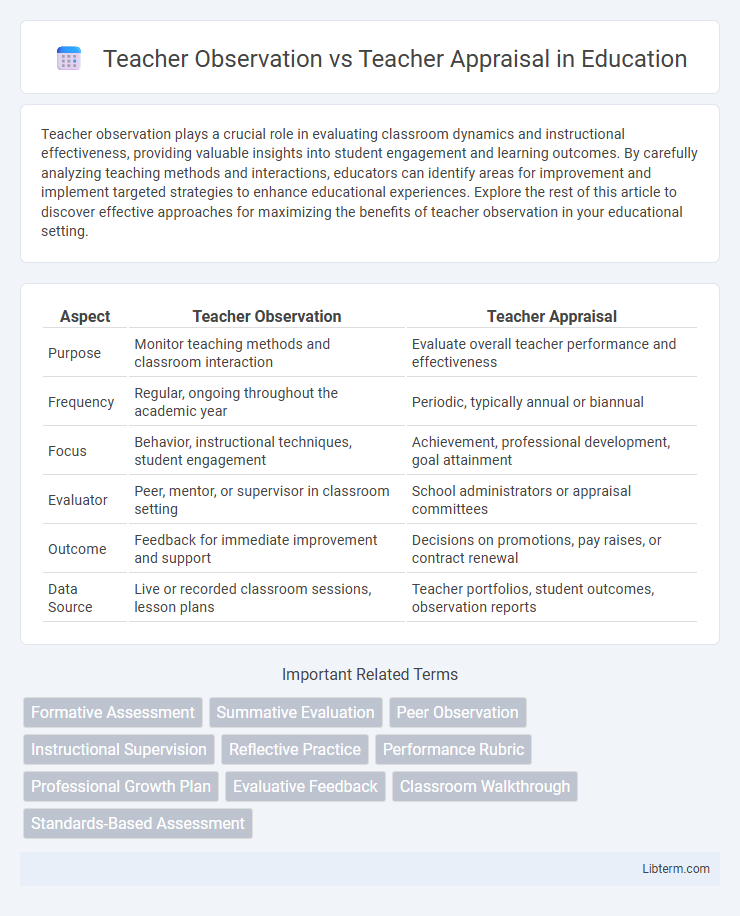Teacher observation plays a crucial role in evaluating classroom dynamics and instructional effectiveness, providing valuable insights into student engagement and learning outcomes. By carefully analyzing teaching methods and interactions, educators can identify areas for improvement and implement targeted strategies to enhance educational experiences. Explore the rest of this article to discover effective approaches for maximizing the benefits of teacher observation in your educational setting.
Table of Comparison
| Aspect | Teacher Observation | Teacher Appraisal |
|---|---|---|
| Purpose | Monitor teaching methods and classroom interaction | Evaluate overall teacher performance and effectiveness |
| Frequency | Regular, ongoing throughout the academic year | Periodic, typically annual or biannual |
| Focus | Behavior, instructional techniques, student engagement | Achievement, professional development, goal attainment |
| Evaluator | Peer, mentor, or supervisor in classroom setting | School administrators or appraisal committees |
| Outcome | Feedback for immediate improvement and support | Decisions on promotions, pay raises, or contract renewal |
| Data Source | Live or recorded classroom sessions, lesson plans | Teacher portfolios, student outcomes, observation reports |
Understanding Teacher Observation
Teacher observation involves systematically watching and documenting a teacher's instructional methods and classroom management to provide qualitative feedback aimed at professional growth. This process emphasizes formative assessment, helping educators reflect on their teaching practices and identify areas for improvement without linking directly to performance ratings or evaluations. Understanding teacher observation as a developmental tool fosters a supportive environment focused on enhancing instructional effectiveness and student outcomes.
Defining Teacher Appraisal
Teacher appraisal is a systematic evaluation process that measures a teacher's performance based on predefined criteria such as instructional skills, classroom management, and student outcomes. It involves formal assessments, often conducted annually, to inform professional development, career progression, and accountability. Unlike teacher observation, which focuses primarily on momentary classroom behaviors, teacher appraisal integrates multiple data sources including self-assessments, student feedback, and standardized test results to provide a comprehensive performance review.
Key Differences Between Observation and Appraisal
Teacher observation involves real-time monitoring of classroom instruction to assess teaching methods and student engagement, providing immediate, formative feedback for professional growth. Teacher appraisal is a comprehensive evaluation process that incorporates multiple data sources, such as observations, student performance, and self-assessments, aimed at determining overall teacher effectiveness and informing personnel decisions. The key differences lie in observation's focus on ongoing, specific instructional practices versus appraisal's broader, summative judgment of a teacher's performance over time.
Purposes of Teacher Observation
Teacher observation primarily aims to provide real-time feedback on instructional practices and classroom management, fostering professional growth and improving teaching effectiveness. It enables administrators and peers to identify strengths and areas for improvement, thereby supporting targeted professional development. Unlike teacher appraisal, which often centers on performance evaluation and accountability, observation focuses more on ongoing formative assessment and collaborative coaching.
Objectives of Teacher Appraisal
Teacher appraisal aims to evaluate educators' performance through a structured process that includes setting clear goals, assessing instructional effectiveness, and providing constructive feedback to enhance professional development. This systematic evaluation supports accountability, identifies strengths and areas for improvement, and informs decisions related to promotion, tenure, and professional growth. By aligning appraisal objectives with school standards and student learning outcomes, teacher appraisal fosters continuous improvement and instructional quality.
Methods Used in Teacher Observation
Teacher observation methods primarily include direct classroom observation, video recordings, and peer reviews, enabling evaluators to assess teaching strategies, student engagement, and classroom management in real-time. Structured observation tools, such as rubrics and checklists aligned with specific teaching standards, ensure consistency and objectivity during evaluations. These methods provide qualitative data that complement quantitative appraisal metrics, enhancing the overall assessment of teacher effectiveness.
Techniques for Effective Teacher Appraisal
Teacher appraisal techniques center on systematic classroom observations, performance evaluations, and feedback mechanisms to ensure instructional quality and professional growth. Utilizing structured observation protocols and digital tools enhances consistency and objectivity in measuring teaching effectiveness against established standards. Incorporating self-assessment and peer reviews fosters reflective practice and collaborative development, optimizing overall teacher appraisal outcomes.
Benefits and Challenges of Observation
Teacher observation provides immediate, real-time insights into classroom dynamics, enhancing professional development through direct feedback and peer collaboration. Challenges include the subjectivity of observations and potential discomfort for teachers, which may affect performance authenticity. Despite these challenges, observation fosters reflective practices and targeted instructional improvements, benefiting overall teaching quality.
Advantages and Drawbacks of Appraisal
Teacher appraisal provides a structured framework for evaluating instructional effectiveness, promoting accountability, and guiding professional development through regular performance reviews. However, appraisal systems may face drawbacks such as potential bias, stress for educators, and an overemphasis on quantitative metrics that could overlook qualitative aspects of teaching. Despite these challenges, well-designed appraisals encourage continuous improvement and help align teaching practices with institutional goals.
Integrating Observation and Appraisal for Professional Growth
Teacher observation offers real-time insights into instructional practices, while teacher appraisal provides a structured evaluation based on performance metrics and standards. Integrating observation and appraisal fosters continuous professional growth by combining formative feedback with summative assessments, enabling targeted development plans. This integrated approach enhances instructional effectiveness, supports reflective practices, and aligns teacher development with school-wide goals.
Teacher Observation Infographic

 libterm.com
libterm.com